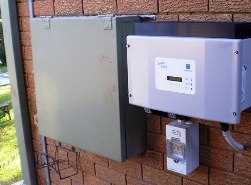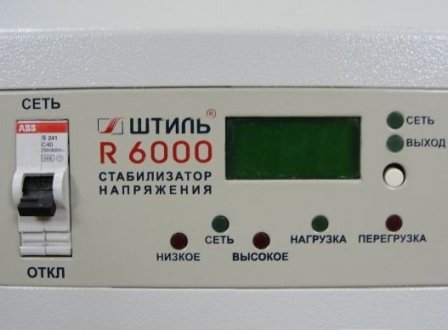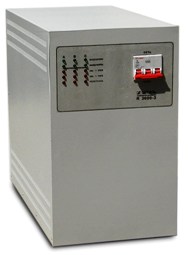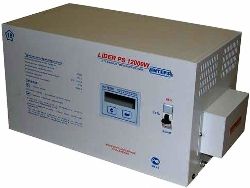Categories: Featured Articles » Electrician at home
Number of views: 95228
Comments on the article: 17
Criteria for choosing a voltage stabilizer for the home
 For those who often spend their holidays outside the city or live in the countryside, the problem of constant voltage drops in the power grid has long been known. She is very annoying because often leads to failure of both lighting and large and expensive appliances such as refrigerators, microwave ovens, air conditioners, etc.
For those who often spend their holidays outside the city or live in the countryside, the problem of constant voltage drops in the power grid has long been known. She is very annoying because often leads to failure of both lighting and large and expensive appliances such as refrigerators, microwave ovens, air conditioners, etc.
There are many ways to deal with unsatisfactory quality of voltage in the mains, but probably the simplest is installation of a voltage stabilizer. Such stabilizers are common house (high power) and local, i.e. low power for a specific device. If you have enough money, then bypass stabilizer preferred since It protects your entire home, not just a specific appliance.
Where to begin?
The first thing to do before choosing a voltage regulator is to determine its power. Ideally, it should be 30 percent higher than the total power of all your electrical appliances. At maximum power, the stabilizer is very hot and quickly turns off automatically. Based on practical experience, we can recommend taking common house stabilizer with a power of at least 5 kW.
This is due to the fact that turning on the electric kettle and the washing machine, you immediately exceed this norm. Therefore, if you bought a stabilizer without a power margin, you will have to limit your energy consumption. Protection of the stabilizer, when exceeding the permissible power, will disconnect the load and you will remain in the dark.
In order to make it easier for you to calculate the total power of electrical appliances, we present their average power: kettle 2 kW; washing machine 3 kW; refrigerator 0.6 kW; Microwave oven 1.5 kW; vacuum cleaner 1 kW; TV 0.15 kW; computer 0.2 kW; hair dryer 1.5 kW; water heater 2 kW; electric pump 0.6 kW. More accurate data are given in the passports for these devices.

What are voltage stabilizers?
 After you have decided on the power of the stabilizer, we recommend that you decide how much money you are willing to give for the stabilizer. The fact is that with the same power, these devices can vary in price several times. The most expensive, but also the highest quality ones, are double conversion inverter voltage stabilizers. They differ in the largest range of input voltage (115-290 V), high regulation speed (units of milliseconds) and high accuracy of maintaining the output voltage - 1-5%.
After you have decided on the power of the stabilizer, we recommend that you decide how much money you are willing to give for the stabilizer. The fact is that with the same power, these devices can vary in price several times. The most expensive, but also the highest quality ones, are double conversion inverter voltage stabilizers. They differ in the largest range of input voltage (115-290 V), high regulation speed (units of milliseconds) and high accuracy of maintaining the output voltage - 1-5%.
In addition, such stabilizers usually have additional services: increasing the cosine phi; surge protection; advanced indication of modes, etc.
The cheapest are relay and ferroresonant stabilizers. The first ones are cheap only if they are low-power, very bulky and have the smallest input voltage range, do not work well when the network frequency changes. Almost not produced at high power, because at a cost become comparable with inverter. Relay stabilizers are characterized by a limited resource, which is determined by the resource of the built-in relays.
More preferable in price and consumer properties. triac stabilizers and servo stabilizers. The latter has an electric motor that moves the carbon electrode along the autotransformer winding. Therefore, stabilizers with a servo drive very slowly track changes in the input voltage, and with sharp surges, they are useless.
Triac stabilizers, these are stabilizers with an autotransformer, but instead of control relays they are used there triacs. These electronic devices have a switching resource of 2-3 orders of magnitude greater than that of electronic relays.Thus, if we talk about a compromise between price and consumer properties, our choice is triac voltage stabilizers.
Where to put the voltage regulator?
The next stage of selection is form factor selection. Stabilizers of 5 kW and above are rather bulky and heavy devices. Therefore, you need to decide in advance in which place in the apartment or house they will be with you. In any case, this place should be close to introductory switchboard. There are floor and wall options, but better options with installation in a special rack. It is bought separately or can be made independently.
The rack version is preferred for several reasons: such a design is more convenient to maintain; no need to drill a wall near the switchboard, where there are always a lot of wires, there are switches in the rack for direct emergency connection of the load to the network (bypass).
Additional service.
 When buying, pay attention to the presence in the stabilizer of devices for indicating modes and voltages. This will help a lot in case of various malfunctions, as well as if you decide to make a complaint to the electricity supplier regarding the non-compliance of its GOST parameters.
When buying, pay attention to the presence in the stabilizer of devices for indicating modes and voltages. This will help a lot in case of various malfunctions, as well as if you decide to make a complaint to the electricity supplier regarding the non-compliance of its GOST parameters.
Everything for homemade.
Here are some examples of the implementation of such stabilizers: http://www.ntpo.com/electronics/schemes_4/12.shtml, a full description, circuit diagram, printed circuit board and the design of a 6 kW network triac stabilizer are given. The circuit is assembled on widespread discrete parts and general purpose microcircuits.
conclusions. You need an AC voltage stabilizer if mains voltage It differs greatly from the generally accepted standard + - 10% of 220 (380) V, and if expensive appliances are installed in your house. It is possible to independently manufacture such a stabilizer, this will reduce your costs by 3-5 times.
See also at bgv.electricianexp.com
:
